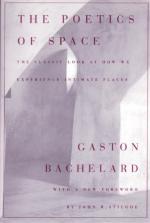
|
| Name: _________________________ | Period: ___________________ |
This test consists of 15 multiple choice questions and 5 short answer questions.
Multiple Choice Questions
1. What does Bachelard identify as the fatal flaw of locked boxes?
(a) Locked boxes defy discovery.
(b) Locked boxes prevent intimacy.
(c) Locks can be broken and trick boxes can be figured out.
(d) Locks give negative energy to a house.
2. According to Bachelard's topoanalysis, what term can be used to describe city apartments?
(a) Superimposed boxes.
(b) Ultra-cellars.
(c) Superimposed cellars.
(d) Ultra-boxes.
3. Bachelard uses what to illustrate the reality of poetic imagery?
(a) The idea of a house.
(b) Psychoanalysis.
(c) Science.
(d) The idea of a painting.
4. What is a commitment of the soul according to the author?
(a) Psychoanalysis.
(b) Poetry.
(c) Death.
(d) Shelter.
5. Rilke wrote that storms seem more aggressive and hostile where?
(a) In the countryside.
(b) In cities.
(c) In the winter.
(d) In the summer.
6. To what iconic Van Gogh image does the author compare a bird's nest on the ground?
(a) Sunflower.
(b) Thatched cottage.
(c) Corn stalk.
(d) Childhood home.
7. For psychoanalysts, what do conflicted locks and keys in dreams symbolize?
(a) Repression.
(b) New discoveries.
(c) Temptations.
(d) Sexual intimacy.
8. The philosopher Minkowski conducted an analysis of what?
(a) Poetic imagery.
(b) Reverberation.
(c) Beingness.
(d) Causality.
9. How does Bachelard say we experience a house buried in a blanket of snow in what way?
(a) As a baby in a cradle.
(b) As a universal child from centuries earlier.
(c) As a warning of death.
(d) As a butterfly in a chrysalis.
10. Bachelard theorizes that dreams of nests inspire what?
(a) Fear of flying.
(b) Poetry.
(c) Dreams of security.
(d) A desire to have a home that opens to nature.
11. According to Bachelard, which level of a house is always dark and shadowy, like the unconscious?
(a) The sleeping level.
(b) The cellar.
(c) The attic.
(d) Every level.
12. Why does Bachelard disagree with Bergson's metaphor of drawers to describe the human brain?
(a) He wonders how reason determines which drawer should contain each new object.
(b) Items get lost in drawers.
(c) He wonders how objects would be retrieved from the drawers.
(d) A chest of drawers is finite, while the brain's capacity is infinite.
13. Childhood is held motionless, states Bachelard, by dreaming of what?
(a) Nursery rhymes.
(b) The phenomenology of motherhood.
(c) The house where one was born.
(d) Stick-figure drawings.
14. Who claimed that only the image can keep up with the changes of nature?
(a) Michelet.
(b) Bachelard.
(c) Pasternak.
(d) Vlaminck.
15. For Bachelard, topophilia can be described in what way?
(a) Happy space that is eulogized and enjoyed.
(b) Fears related to a house's interior space.
(c) Fear of steep hillsides.
(d) The nature of a plot of land, whether flat or sloped.
Short Answer Questions
1. What do poets create, according to Bachelard, to transcend conflicted night dreams?
2. Memories and images of previous dwelling places converge where according to the author?
3. When memories reside in parts of a house, which of the following is true in the author's opinion?
4. Poetic imagery is real, according to Bachelard, even though it is not subject to what?
5. Central to the author's main theme in "Nests," how does a simple image avoid intimidation?
|
This section contains 552 words (approx. 2 pages at 300 words per page) |

|




